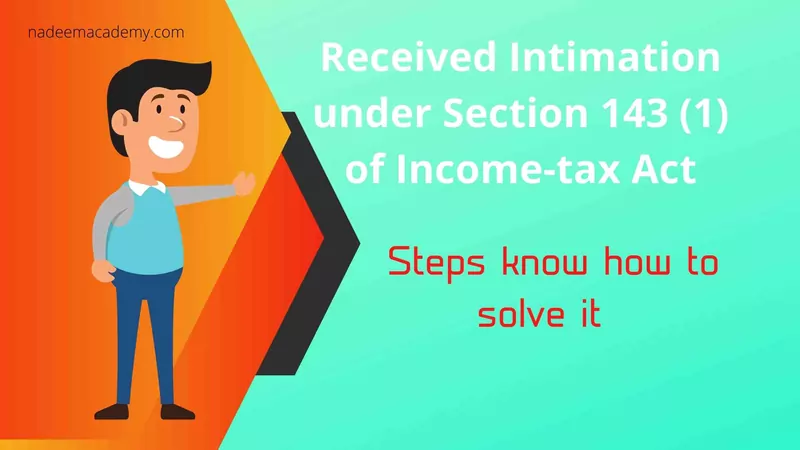What is Intimation under Section 143 (1)
At the Centralised Processing Centre (CPC), the taxpayer’s income tax returns are first processed online. Then income tax department issues intimation under section 143(1) to the taxpayers after processing the return and later informing them about the results.
Letter of Intimation u/s 143 (1):
An income tax return can be filed voluntarily under Section 139 or on-demand under Section 142(1) by the income tax department. It is essential to know that what happens after the taxpayer has filed the return of income. Typically, the income tax department carries out a preliminary assessment of all the returns filed and informs all the taxpayers of such preliminary assessment.
This assessment usually includes errors that occurred arithmetically, internal inconsistencies, tax and tax payment verification calculations. Such communication with the taxpayer post the preliminary assessment, known as intimation under Section 143(1). The preliminary assessment is wholly computerized, without any human intervention, and the Centralised Processing Center (CPC) is delegated.
Centralized Processing Center (CPC):
With the severe growth in the number of income tax returns and a jurisdiction-based processing model for all the returns filed, the tax department is facing problems leading to delaying income tax returns.
Hence, the Finance Act, 2008, has empowered the Central Board of Direct Taxes (CBDT) to make a scheme for centralized processing of returns to expeditiously determine the tax payable by or the refund due to the taxpayers.
Based on the Group of Technical Advisory suggestions, the department has adopted the strategy that the Centralized Processing Centre at Bangalore would process paper and e-returns without any interface with taxpayers and in a jurisdiction-free manner.
The Centralized Processing Centre project envisaged benefits for the citizens as well as the tax department. It leads towards faster and hassle-free preliminary processing of their returns. It relieved the department from the burden of preliminary assessment that can be computerized and enabled them to concentrate on hardcore activities.
Any communication by the income tax department creates panic for the taxpayers. However, according to Section 143(1), intimation is not something one needs to worry about. In this article, we would discuss intimation sent under Intimation under Section 143 in detail to help taxpayers deal with such intimation with ease.
Preliminary Assessment under Intimation under Section 143:
Initial processing of returns by CPC is wholly automated, and Section 143(1) Intimation is also a computer-generated record. Centralized PC validates data provided in each tax return with details available with the income tax department’s record (such as form 26AS generated through details provided by collecting banks, form 16, TDS returns, etc.). Usually, this notice only points out apparent mistakes which the mainframe system can trace.
Once the filing of the return is done, total income or loss can be recomputed by the computerized system as per the department’s records; it compares the taxpayer files.
The intimation is having two columns: ‘As provided by the taxpayer in the Return of Income‘ and ‘as computed under Intimation under Section 143 (1).
Comparison is made for significant categories like
- Income under various heads,
- Gross Total Income,
- Deductions made under Chapter VIA (80C, 80D etc.), and
According to the advance tax and self-assessment tax structure, the taxpayers make the Tax deducted at the source and tax payments.
Appropriate adjustments have been made for income as computed under Section 143(1), and the final tax liability or refund has arrived.
The adjustments can be carried out only after giving any intimation to the taxpayer of the proposed adjustments in writing or electronic mode, i.e., to the email id provided during the income tax return filing.
Individual responses received from the taxpayer within 30 days from the issuance date of intimation will be considered before making the final adjustment. If no response is received within such a period, adjustments arrived at initially will be incorporated.
After arriving at the final tax liability, the same has been adjusted against TDS and tax payments and several other reliefs under Section 90/91, if any.
An intimation can be prepared and also can be sent to the assessee.
Kind of intimations which are possible have been discussed below:
Intimation with no refund or no demand – Generally, this happens if the department has accepted the return as a filing type without any adjustments carried out for it.
Determining intimation of demand – It is issued in case of adjustments made under Section 143 (1) due to an arrived discrepancy found and tax liability.
Determining intimation of refund – It is issued where any interest or Tax is refundable either where no discrepancy is found in return which is already filed or after making adjustments as mentioned in Section 143(1) and after giving credit to the taxes and interest paid by the taxpayer.
While demand notice is sent in final tax liability, refunds shall be granted to the taxpayer, if any.
Some illustrations of an intimation under 143 (1):
Reason of adjustments under 143(1):
Total income or loss which is computed under Intimation under Section 143 after making the below adjustments:
Having arithmetical error in the return
Any claim which is incorrect and is apparent from any information in the return where the incorrect claim indicates the following:
The claiming of an item in the return which is inconsistent with another entry of the same category or some other item in such return like –
E.g., Income from other sources is deducted from business income but not declared under income from other sources.
Disallowance of set-off of loss in the financial year is carried forward from previous years in which return was filed beyond the due date specified.
Disallowance of expenditure is indicated in the audit report but not indicated in the return of income.
Time Limit for the issue of Intimation under Section 143:
Under Section 143(1), intimation must be sent within one year from the end of the financial year in which the return have to be filed. E.g., if the taxpayer filed a return about the financial year 2019-20 in July 2019, intimation can be sent till 31 March 202 at any time. Suppose a taxpayer does not receive any intimation within such period. In that case, in simple words, means there are no adjustments that can be carried out to the return which the taxpayer has filed, and no change in tax liability/refund and acknowledgment which have been filed itself can be deemed under Section 143(1) intimation.
Action which is to be taken by the taxpayer after receiving a Intimation under Section 143:
As a first step, a review of certain things in Section 143(1) intimation is necessary to ensure the document pertaining to your return and the data provided for about the same financial year as mentioned under Section 143(1) intimation.
Checking the name, PAN, address, assessment year for which notice has been sent, e-filing acknowledgment number.
If you can identify the mistakes you have made while filing your return from the 143(1) intimation and can be rectified by filing a revised return; please log into the income tax filing website. Please refer to our article on how you can go about revising your return online.
However, suppose no mistakes have been made, and you disagree with the adjustments made by CPC/computerized system. In that case, you can file an online rectification application under Section 154(1), intimating the correction of the mistake appearing in Section 143(1) intimation. Refer to our article on filing rectification applications.
If you are not been satisfied with the processing of your rectification return by Centralized Processing Centre, you can also file online grievances or even you can contact your assessing officer. In case of no good action from the CPC/assessing officer, you can file a complaint to the income tax ombudsman.
However, if the taxpayer agrees to the tax demand raised by the income tax department after carrying out adjustments as above, the taxpayer is required to pay such taxes. Refer to our article on OLTAS challan payment on how to pay taxes. However, while paying Tax on the demand raised under this Section, please choose ‘Tax on regular assessment (400)’ under the type of challan payment.
Questions which are frequently asked.
What if I have not received my intimation under Intimation under Section 143 even after the end of the above specified period?
The acknowledgment of the return should be deemed to be the intimation in a case where no amount is payable by, or even refundable, the assessee and where no adjustment has to be made.
I have receive a demand notice under section 143(1) for paying an amount of 5000 INR. What should I do?
If you agree with the demand of tax, it is necessary for you to pay the Tax. Under the type of payment in the challan, choose the tax on regular assessment (400).

My Name is Nadeem Shaikh the founder of nadeemacademy.com. I am a Qualified Chartered Accountant, B. com and M.Com. having professional and specialize experience in field of Account, Finance, and Taxation. Total experience of 20 years in providing businesses solution in Taxation, Accounting, and Finance with all statutory compliance with timely business performance Financials reports. You can contact me on nadeemacademy2@gmail.com or contact@nadeemacademy.com.
